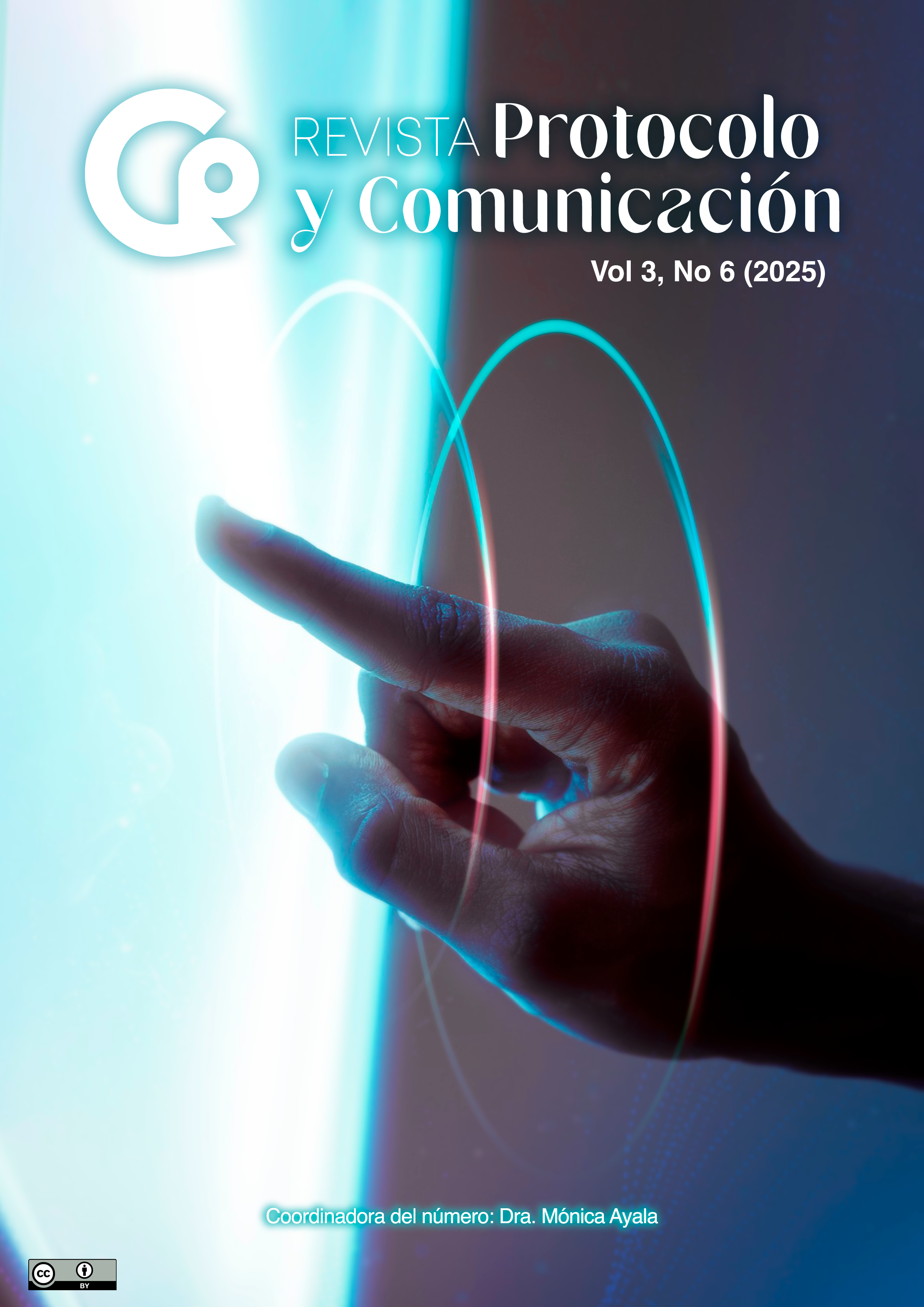Uso de TikTok en la reconfiguración de imaginarios culturales en jóvenes indígenas ecuatorianos
DOI:
https://doi.org/10.58703/rpyc.v3n6a1Palabras clave:
Ecuador, Glocalización, identidad digital, imaginarios culturales, juventudes, TikTokResumen
Este artículo analiza cómo los jóvenes indígenas ecuatorianos utilizan TikTok como un espacio de producción simbólica, desde el cual reconfiguran imaginarios culturales y desarrollan procesos de resignificación identitaria. La investigación adopta un enfoque cualitativo y se sustenta en un marco conceptual que articula las nociones de imaginarios culturales, glocalización, performatividad e identidad digital. La metodología fue diseñada a partir de una revisión crítica de literatura académica relevante y un análisis de contenido aplicado a perfiles seleccionados por su relevancia sociocultural y expresividad étnica.
Los resultados muestran que los jóvenes no solo adaptan tendencias globales con creatividad y códigos locales, sino que también elaboran narrativas de pertenencia, visibilización y resistencia cultural frente a los procesos globalizadores que atraviesan las redes sociales. Elementos como el uso del idioma Kichwa -una de las diez lenguas indígenas que aún se mantienen vivas en Ecuador, hablada en casi toda la Sierra y parte de la Amazonía-, la representación de paisajes andinos, la comida tradicional o la vestimenta, evidencian cómo lo local se inscribe en lógicas digitales globales, sin perder su esencia ni su anclaje territorial.
Sin embargo, esta transformación también pone en evidencia las tensiones que se generan tanto dentro como fuera de las comunidades en torno a la representación cultural. Lo que confirma que TikTok no es un entorno neutro, sino un espacio en disputa, donde las juventudes negocian signos y significados con una mirada crítica sobre lo cotidiano y reconfiguran nuevas formas de ciudadanía cultural desde una perspectiva profundamente ecuatoriana.
Referencias
1. Albarrán, E. J. (2021). Globalizing the Americas through twentieth-century youth organizations. In The Oxford Handbook of the History of Youth Culture. Oxford University Press. https://doi.org/10.1093/oxfordhb/9780190920753.013.17
2. Bollington, L., & Merchant, P. (2020). Latin American culture and the limits of the human. University of Florida Press. https://doi.org/10.2307/j.ctvzgb67d
3. Burgaleta-Pérez, E., & De Santis, L. (2024). Gender, ethnicity, and age on TikTok: Content analysis of Ecuadorian tiktokers. South Eastern European Journal of Public Health, 25(S1), 2707–2715. https://doi.org/10.70135/SEEJPH.VI.2510
4. Charmaz, K. (2020). Theoretical sampling, saturation, and sorting. In Constructing grounded theory (2nd ed., pp. 197–227). SAGE Publications. https://doi.org/10.4135/9781526402236
5. Céntrico Digital. (2021). Voces digitales indígenas: Un estudio de investigación por Céntrico Digital. https://centricodigital.com/
6. Cortés-Morales, S., & Morales-Retamal, C. (2022). Vaulting the turnstiles: Dialoguing and translating childhood and agencies from Chile, Latin America. Third World Thematics: A TWQ Journal, 7(2–3), 162–180. https://doi.org/10.1080/23802014.2022.2065025
7. De Freitas, F. A., Colares, E., & Gouvêa, M. C. S. (2021). Infâncias e agência política em ações coletivas e movimentos sociais latino-americanos. Revista Linhas Críticas, 27, 1–21. https://doi.org/10.26512/LC.V27.2021.35057
8. DPL News. (2024, enero 24). Influencers indígenas usan redes sociales para preservar tradiciones y defender derechos. https://dplnews.com/influencers-indigenas-usan-redes-sociales-para-preservar-tradiciones-y-defender-derechos/
9. Flick, U. (2023). Introducing research methodology: Thinking your way through your research project (4th ed.). SAGE Publications.
10. Gibbons, J., Poelker, K. E., & Hasbun, K. (2021). My social, political, and hybrid self: Identity in Central and South America. In Identity in a Changing World (pp. 45–67). Springer. https://doi.org/10.1007/978-3-030-77242-0_4
11. Habermas, J. (1989). The structural transformation of the public sphere: An inquiry into a category of bourgeois society. MIT Press.
12. Hernández, J., & Newhart, V. (2022). Latine health and development in the digital age. Interactions, 29, 39–43. https://doi.org/10.1145/3550199
13. Hiebert, A., & Kortes-Miller, K. (2023). Finding home in online community: Exploring TikTok as a support for gender and sexual minority youth throughout COVID-19. Journal of LGBT Youth, 20(4), 800-817.
14. Kawashima, T. (2024). The Role of TikTok in Shaping Cultural Identity Among Young ACGN Fans in Japan. Studies in Social Science & Humanities. https://doi.org/10.56397/sssh.2024.12.04
15. Kim, M. (2020). Korean reality television-travel shows in constructing Latin American cultural identities. In Media and Cultural Representations (pp. 161–183). Springer. https://doi.org/10.1007/978-3-030-55773-7_7
16. Lacan, J. (2007). Escritos I (J. A. Miller, Ed.; T. Sauret, Trad.). Siglo XXI. (Original publicado en 1949)
17. Lacasa, P., Carbonell-Bernal, N., Duran-Bonavila, S., & Contreras-Pulido, P. (2022). Héroes, ídolos y Jóvenes influencers: Industrias Culturales y modelos de identidad en TikTok. Techno review. International Technology, Science and Society Review/Revista Internacional de Tecnología, Ciencia y Sociedad, 11(2.4), 1-16. https://doi.org/10.37467/revtechno.v11.4391
18. Lin, M. J. (2001). How Taiwanese youth interpret Western programming: the impact of imported programming on youth self identification.
19. Manzanero, J. R. L. (2021). Youth in Latin America and the Caribbean in perspective: Overview of the situation, challenges and promising interventions. Ciencia & Saúde Coletiva, 26(7), 2565–2573. https://doi.org/10.1590/1413-81232021267.07272021
20. Markham, A., Buchanan, E., & with feedback from the AOIR Ethics Working Committee. (2012). Ethical decision-making and internet research: Recommendations from the AoIR Ethics Working Committee (Version 2.0). https://aoir.org/reports/ethics2.pdf
21. McIlwaine, C. (2024). Cartographies of emergence of Latin American communities and British Latinx imaginaries in London. Bulletin of Latin American Research. https://doi.org/10.1111/blar.13607
22. Nowell, L. S., Norris, J. M., White, D. E., & Moules, N. J. (2022). Thematic analysis: Striving to meet the trustworthiness criteria. International Journal of Qualitative Methods, 21, 1–13. https://doi.org/10.1177/1609406917733847
23. Patton, M. Q. (2019). Qualitative research & evaluation methods (4th ed.). SAGE Publications.
24. Pinheiro, L. R., Di Leo, P. F., & Ramírez Varela, F. (2023). Youth itineraries, individuation, and reflexivities: Approaches to social participation in low-income metropolitan neighborhoods. Educação e Pesquisa. https://doi.org/10.1590/s1678-4634202349270569en
25. Pinto Arboleda, M. C., Barreneche Corrales, J., & Alcoceba Hernando, J. A. (2020). Identidad juvenil latinoamericana a través del análisis de los discursos sociocomunicativos glocales. OBETS: Revista de Ciencias Sociales, 15(2), 649–672. https://doi.org/10.14198/obets2020.15.2.10
26. Rivera, S., Etchegaray, N., Gil de Zúñiga, H., & Correa, T. (2024). Seeking justice on social media: Funas as a localized form of Latin American youth activism. New Media & Society. https://doi.org/10.1177/14614448241283943
27. Robertson, R. (1995). Glocalization: Time-space and homogeneity-heterogeneity. En M. Featherstone, S. Lash & R. Robertson (Eds.), Global modernities (pp. 25–44). SAGE Publications Ltd. https://doi.org/10.4135/9781446250563.n2
28. Salazar-Vallejo, D., & Rivera-Rogel, D. (2023). La red social TikTok y su incidencia en el cambio de comportamiento. Revista de Comunicación y Sociedad, 2(2), 45–60. https://www.scielo.org.ar/scielo.php?pid=S2250-41842024000200005&script=sci_arttext&tlng=es
29. Sánchez-Aguirre, D., & Alvarado-Sizzo, I. (2023). Imaginaries about intangible cultural heritage and tourism in Mexican Bajio cities. International Journal of Tourism Cities. https://doi.org/10.1108/ijtc-01-2023-0006
30. Schreier, M. (2021). Qualitative content analysis in practice (2nd ed.). SAGE Publications.
31. Smith, J. C. A. (2021). Southern lights: Metropolitan imaginaries in Latin America. Thesis Eleven, 166, 118–135. https://doi.org/10.1177/07255136211043923
32. Snyder, H. (2019). Literature review as a research methodology: An overview and guidelines. Journal of Business Research, 104, 333–339. https://doi.org/10.1016/j.jbusres.2019.07.039
33. Soares, T., & Pereira, S. L. (2023). Paquete digital as media format for cultural consumption in Cuba. Revista Foro Cubano. https://doi.org/10.22518/jour.rfc/2022.5a06
34. Stahl, C. C., & Literat, I. (2022). #GenZ on TikTok: The collective online self-portrait of the social media generation. Journal of Youth Studies, 26(7), 925–946. https://doi.org/10.1080/13676261.2022.2053671
35. Tamim, T., Alghamdi, A. K. H., & Alghamdi, A. (2021). Youth practice of humor and resistance through TikTok trends. Social Media Performance in School, 12(3), 123–135. https://www.researchgate.net/publication/379208390
36. Vacca, R. (2024). Algorithmic counterspaces: Exploring Afro-Latino youth information practices using TikTok. Information and Learning Sciences. https://doi.org/10.1108/ils-12-2023-0209
37. Vázquez, D. J. (2021). Mapping decolonial environmental imaginaries in Latinx culture. American Literary History. https://doi.org/10.1093/alh/ajab054
38. Waechter, N. (2021). “Glocalized” digital youth cultures. In Youth and the Media (pp. 227–243). Springer. https://doi.org/10.1007/978-3-030-65177-0_14
39. Waechter, N. (2021). Estructura mediática de TikTok: Estudio de caso de la red social de videos cortos. Revista Científica de Comunicación e Información, 12(3), 45–60. https://www.revistaccinformacion.net/index.php/rcci/article/view/126
40. Yup de León, P. D., & Álvarez Arzate, M. D. (2021). El concepto de juventud: Una mirada desde la perspectiva generacional. Revista Científica FAREM Estelí UNAN-Managua, (0), 20–35. https://doi.org/10.5377/farem.v0i0.11605
41. Zhao, H., & Wagner, C. (2022). How TikTok leads users to flow experience: investigating the effects of technology affordances with user experience level and video length as moderators. Internet Research, 33(2), 820-849.




